3.1
Radiation Injury
Radiation injury occurs through mechanisms that disrupt cellular structure and function. Theories of radiation injury propose different models explaining how these disruptions translate to health effects. The dose-response curve maps out the correlation between the level of radiation exposure and the severity of the injury. Radiation effects are categorized into stochastic, which are random and increase in probability with dose, and nonstochastic, which increase in severity with the dose and have a threshold. The sequence of radiation injury follows a path from initial exposure to eventual health outcomes. Factors determining the extent of radiation injury include the dose magnitude, rate of exposure, area of the body exposed, and the individual’s biological sensitivity.
Mechanisms of Injury
Some x-rays do not reach the dental x-ray receptor; they are absorbed by the patient’s tissue. Chemical changes occur that result in biologic damage. Two possible mechanisms of radiation injury are ionization and free radical formation.
Ionization
Ionization results when x-rays strike patient tissue. Ionization is produced through the photoelectric effect or compton scatter and results in formation of a positive atom and dislodged negative electron (Ion Pair). This electron will interact with other atoms within the absorbing tissues causing chemical changes within the cell that results in biologic damage. The biologic changes may or may not have affect on cells.
Free Radical Formation
Free radical formation is when cell damage occurs primarily through formation of free radicals. Free radicals are formed when an x-ray photon ionizes water. A free radical is an uncharged atom or molecule that exists with a single, unpaired electron in its outermost shell and is highly reactive and unstable. Radicals are believed to be involved in degenerative diseases and cancers.
The diagram below shows that the x-ray photon interacts with tissues and results in ionization, excitation, or breaking of molecular bonds, all of which cause chemical changes that result in biological damage.
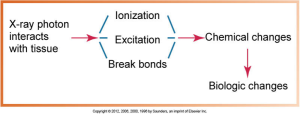
Here is an example of free radicals created when water is irradiated. The diagram below shows x-ray photons interacting with water molecules in cells, leading to ionization and the subsequent formation of free radicals.
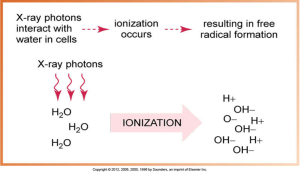
Here is an example of free radicals that can combine with each other to form toxins such as hydrogen peroxide. The diagram below shows a schematic representation of free radicals combining to form hydrogen peroxide (H₂O₂), a toxic compound.
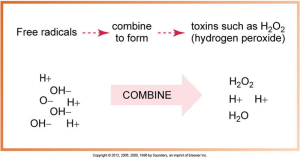
Theories of Radiation Injury
Damage to living tissue is caused by exposure to ionizing radiation may result from a direct hit and absorption of an x-ray photon within a cell and absorption of an x-ray photon by water within a cell accompanied by free radical formation. Two theories to describe how radiation damages biologic tissues are direct theory and indirect theory.
Direct Theory
Cell damage results when ionizing radiation directly hits critical areas within the cell. This occurs infrequently, and most x-rays pass through the cell with little or no damage.
The illustration below shows the development of cancer from mutations produced by ionizing radiation, showing a normal cell mutating into a cancer cell, which then proliferates into a tumor.
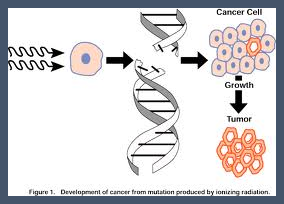
Indirect Theory
X-ray photons are absorbed within the cell and cause the formation of toxins, which in turn damage the cell. When x-ray photons are absorbed by water within a cell, free radical formation results. The free radicals combine to form toxins that damage cells and occur frequently because of the high water content of the cells.
The illustration below shows two pathways of DNA damage: the “Indirect Route” via water and free radicals, and the “Direct Route” by radiation directly hitting the DNA.

Dose-Response Curve
The curve is used to correlate the damage of tissue with the dose of radiation received. A linear, non-threshold relationship is seen. The linear relationship indicates that the response of the tissues is directly proportional to the dose, and the non-threshold dose-response curve suggests that no matter how small the amount of radiation is received, some biologic damage occurs. There is no safe amount of radiation exposure; although the doses received by the patient are low, damage does occur.
Stochastic and Nonstochastic Radiation Effects
Stochastic Radiation Effects
Stochastic effects occur as a direct function of the dose. These effects have no dose threshold; effects do not depend on the magnitude of the absorbed dose. Examples of this are cancer and genetic mutations. The probability of stochastic effects increases with an increase in the absorbed dose.
Nonstochastic Radiation Effects
Nonstochastic (deterministic) effects are somatic effects that have a threshold; effects increase in severity with increasing absorbed dose. Examples of this are erythema, loss of hair, cataracts, and decreased fertility. Nonstochastic effects require large doses of radiation to cause serious health issues.
Sequence of Radiation Injury
The latent period is the time that elapses between exposure to ionizing radiation and the appearance of observable clinical signs. It depends on the total dose of radiation received and the amount of time it took to receive the dose.
The period of injury is a variety of cellular injuries may result.
The recovery period depends on a number of factors; cells can repair the damage caused by radiation.
The cumulative effects is the effects of radiation exposure that are additive, and unrepaired damage accumulates in tissues.
Not all cellular radiation injuries are permanent, and repeated radiation exposure can lead to health problems such as cataracts, cancer, and birth defects.
Tissue and Radiation Effect
| Tissue or Organ | Radiation Effect |
|
|
|
|
|
|
|
|
|
|
|
|
Determining Factors for Radiation Injury
The determining factors for radiation injury are as followed:
- Total dose: quantity of radiation received, or the total amount of radiation energy absorbed.
- Dose rate: rate at which exposure to radiation occurs and absorption takes place. (dose rate = dose/time)
- Amount of tissue irradiated: areas of body exposed to radiation. Total body irradiation produces more adverse effects than small localized areas
- Cell sensitivity: more damage occurs in cells that are most sensitive to radiation (rapidly dividing and young cells)
- Age: children more susceptible to radiation damage than are adults
Radiation Effects
There are Short- and long-term effects from radiation as well a somatic and genetic effects. Radiation effects on cells, tissues, and organs.
Short- and Long-Term Effects
Short-term effects are associated with large doses of radiation in a short amount of time. Acute radiation syndrome (ARS) includes nausea, vomiting, diarrhea, hair loss, and hemorrhaging. Short-term effects can be seen within minutes, days, or weeks and are not applicable to dentistry.
Long-term effects happen when small doses are absorbed repeatedly over a long period of time. Effects are seen after years, decades, or generations with things like cancer, birth abnormalities, and genetic defects.
Somatic and Genetic Effects
Somatic cells are all the cells in the body except the reproductive cells. Somatic means “referring to the body.” Somatic effects are seen in an irradiated person and not seen in future generations.
Genetic cells are the reproductive cells. The biological effects of radiation can be classified as somatic or genetic. Genetic effects are not seen in an irradiated person and are passed on to future generations.
Somatic Mutation
In this example, a somatic mutation produces poor health in the exposed animal but does not produce mutations in subsequent generations. In contrast, a genetic mutation does not affect the exposed animal but produces mutations in future generations.
The illustration below compares genetic mutation and somatic mutation in a dog, showing radiation inducing a genetic mutation that is passed to future generations and a somatic mutation not passed on.
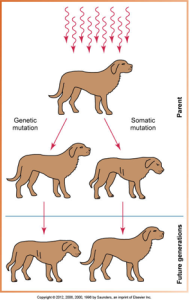
Media Attributions
- Iannucci & Howerton: Dental Radiography Principles and Techniques, 6th Edition, Chapter 3, CC BY-NC-ND

